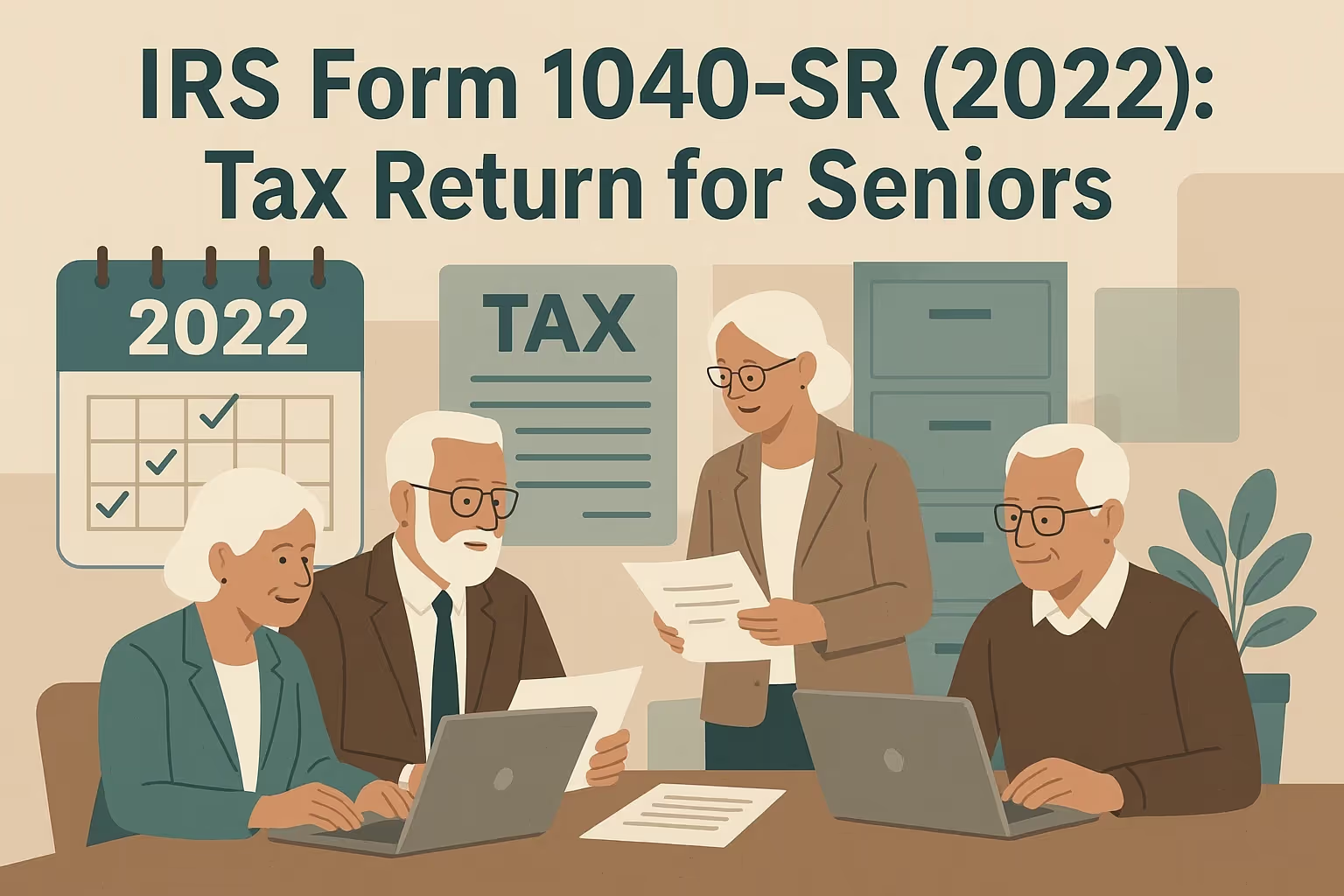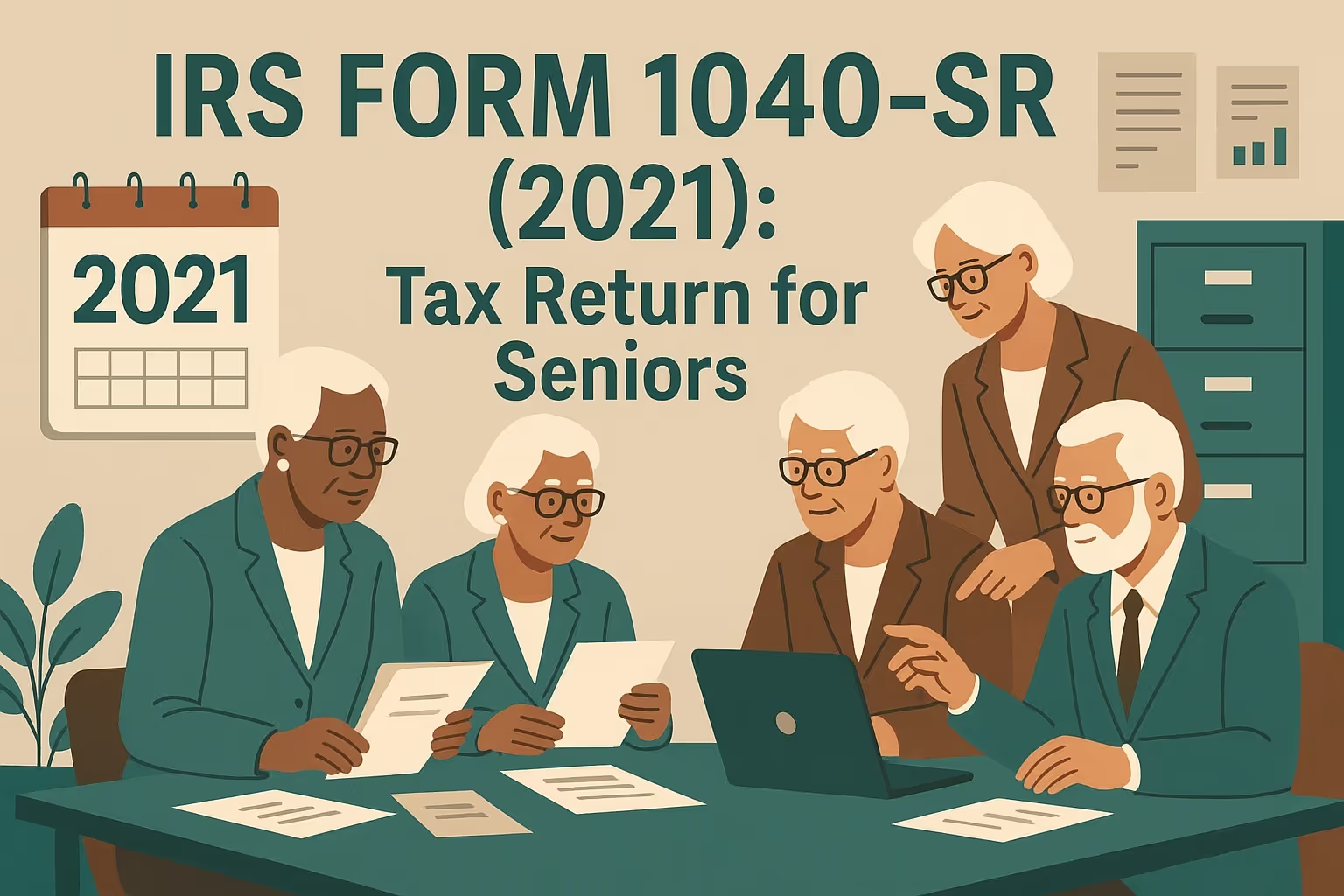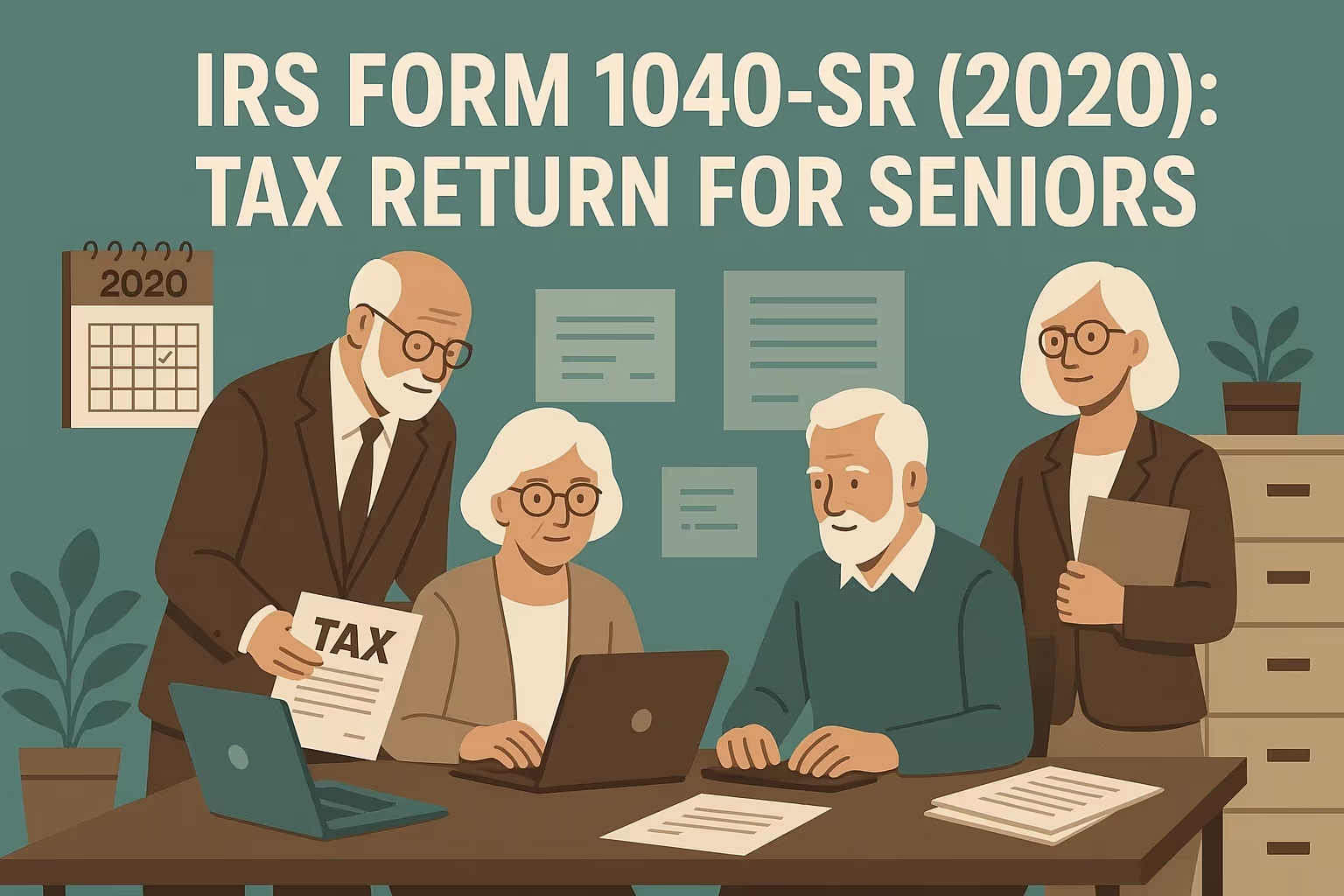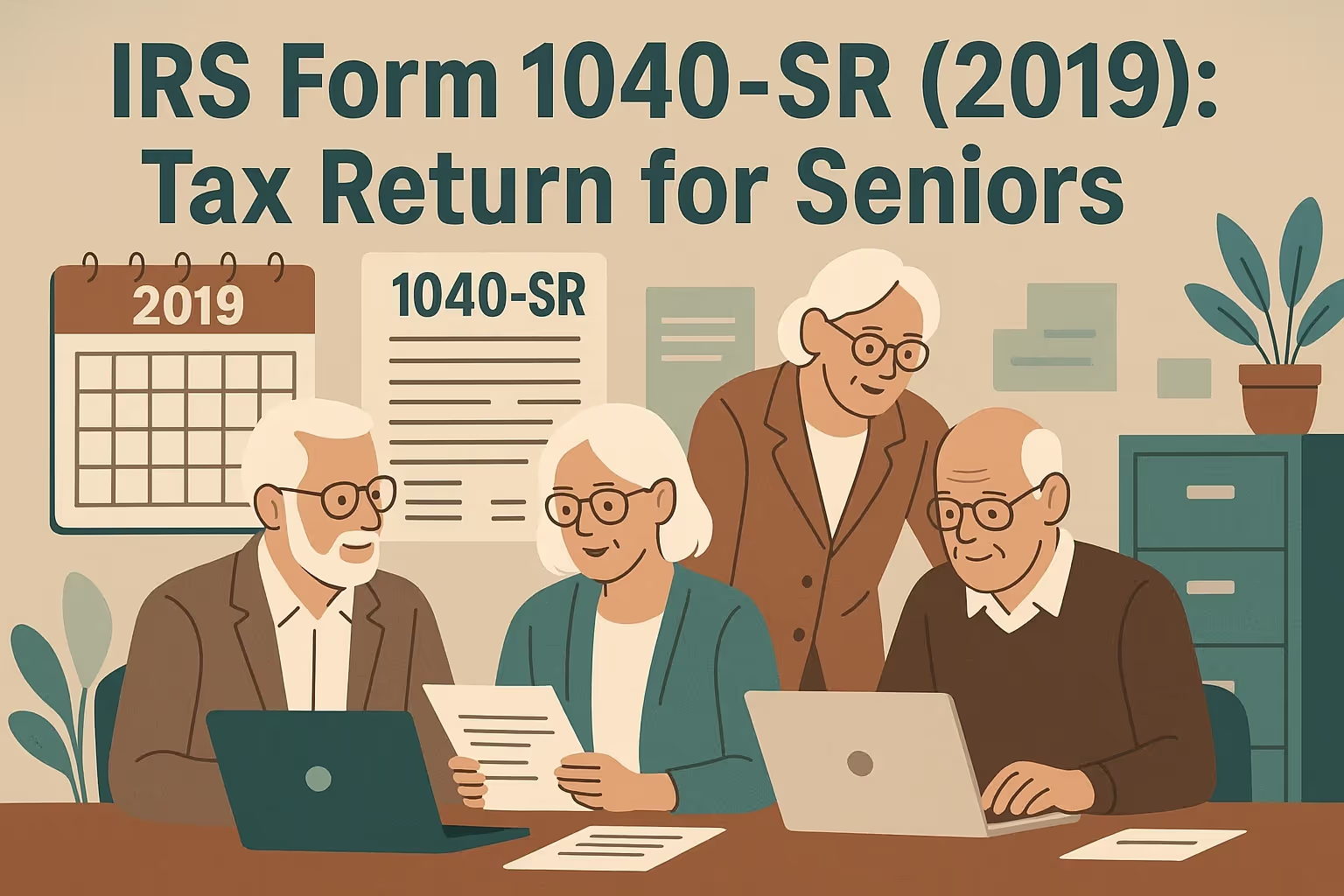Form 1040SR 2022 Instructions: Complete Senior Filing Guide
If you’re 65 or older, you don’t need a complicated tax form to file your federal return. The IRS offers Form 1040-SR, a version of the standard Form 1040 created with seniors in mind. It uses larger print, a more straightforward layout, and an easy-to-read standard deduction chart to see the necessary information without straining your eyes or flipping through multiple pages.
This guide walks you through the instructions for Form 1040SR 2022 step by step. You’ll learn how to report income from retirement accounts, Social Security, pensions, or part-time work, and how to claim deductions and credits that may lower your debt. Each section follows the same order as the form itself, making it simple to check your progress as you go.
Even if you’ve filed other federal tax forms in past years, using Form 1040-SR can make this year’s return less stressful. We’ll cover what changed for the 2022 tax year, what documents to gather, how to e-file or mail your return, and the most common errors to avoid. By the end, you’ll have a transparent process for completing your return accurately and on time—without feeling overwhelmed.
What Is Federal Form 1040-SR?
Form 1040-SR is a federal tax form created by the IRS for adults 65 or older. It serves the same purpose as Form 1040, the standard annual income tax return for most taxpayers, but it includes design features that make it easier to read and complete.
This version uses larger print, wider spacing between line items, and a built-in chart showing the standard deduction amounts for seniors. The more straightforward layout helps older taxpayers review their income sources, deductions, and credits without confusion.
It also keeps the exact schedules and calculations used in Form 1040, which means the information you report—such as wages, dividends, and Social Security benefits—follows identical tax rules.
Who Can Use It
Form 1040-SR is available to taxpayers born before January 2, 1958, who were 65 or older at the end of the 2022 tax year. Joint filers may also use the form even if only one spouse meets the age requirement.
The form remains optional. Eligible seniors may still file the standard Form 1040 instead. Both versions calculate income, deductions, and tax liability similarly. The choice depends primarily on readability and preference.
Benefits for Senior Taxpayers
Form 1040-SR provides several practical advantages for older adults:
- Improved readability: Larger print and clearer formatting help reduce errors caused by misreading line items.
- Simplified deduction guidance: The built-in chart lists standard deduction amounts based on age and filing status, eliminating the need to reference another worksheet.
- Supports common retirement income: The form accommodates Social Security benefits, pension payments, and IRA distributions, which are common income types for seniors.
- Compatible with all filing methods: It can be filed online, mailed, or submitted through a tax preparer using the same process as Form 1040.
What’s New for the 2022 Tax Year
Several updates affected how seniors filed Form 1040-SR for the 2022 tax year. Most changes focused on deduction amounts, credit limits, and revised line items that align with other federal tax forms. Understanding these updates helps taxpayers report income correctly and avoid calculation errors.
Standard Deduction Updates
The IRS raised standard deduction amounts for the 2022 tax year, offering higher deductions for seniors 65 and older. These changes lower taxable income, which can reduce overall tax liability without the need to itemize deductions. The chart below shows the updated amounts for each filing status.
- Base Standard Deduction: $12,950
- Additional Amount for Age 65+ (Per Person): +$1,750
- Total Possible Deduction (2022): Up to $14,700
- Base Standard Deduction: $25,900
- Additional Amount for Age 65+ (Per Person): +$1,400 per spouse
- Total Possible Deduction (2022): Up to $28,700 (if both spouses are 65+)
- Base Standard Deduction: $19,400
- Additional Amount for Age 65+ (Per Person): +$1,750
- Total Possible Deduction (2022): Up to $21,150
- Base Standard Deduction: $25,900
- Additional Amount for Age 65+ (Per Person): +$1,400
- Total Possible Deduction (2022): Up to $27,300
These increases benefit older adults by accounting for higher living and medical costs often accompanying retirement. Most taxpayers over 65 find the standard deduction more valuable than itemizing, especially when relying on retirement income such as pensions, annuities, or Social Security benefits.
Child Tax Credit and Other Changes
The expanded Child Tax Credit introduced in 2021 under the Bipartisan Budget Act was not extended. For 2022, the credit returned to $2,000 per qualifying child, with a refundable portion limited to $1,500. Eligibility depends on the child’s age, dependent status, and income thresholds.
New Form Updates
The 2022 version of Form 1040-SR added clearer income categories on Line 1, now labeled 1a through 1z, for wages and other additional income. It also introduced a mandatory digital asset question and updated the term “qualifying widow(er)” to “qualifying surviving spouse.”
Gather Required Documents Before You File
Gathering every document that reports income, deductions, or credits for the 2022 tax year is vital before completing Form 1040-SR. Complete records help ensure accuracy when filing the annual income tax return and reduce the risk of errors or missing information.
Income Forms
The following records help confirm all taxable income that must be reported on the federal tax forms:
- Form W-2: This form reports wages, salaries, or tips earned from employment during the year.
- Form 1099-INT: This document shows taxable interest earned from savings accounts or investments.
- Form 1099-DIV: Reports dividend income from mutual funds, stocks, and other investments received during the year.
- Form 1099-R: Lists distributions from pensions, annuities, and retirement accounts such as traditional or Roth IRAs.
- Form SSA-1099: Details total Social Security benefits received and identifies the portion that may be taxable for the year.
- Form 1099-MISC or 1099-NEC: These forms report self-employment income, freelance earnings, or other additional income not included elsewhere.
Deduction and Credit Records
Supporting records help verify deductions and refundable credits claimed on the return:
- Property taxes and mortgage interest: Copies of Form 1098 or annual statements help confirm housing-related deductions.
- Medical and charitable expenses: Receipts, billing summaries, or donation letters serve as proof for these deductions.
- State and local taxes: Records of payments or statements from state agencies confirm amounts paid.
- Student loan interest: Year-end lender statements document interest paid that may qualify for a deduction.
Personal Information
Accurate identifying information ensures smooth processing of the tax return:
- Social Security numbers: Confirm correct numbers for the filer, spouse, and dependents.
- Banking details: Verify routing and account numbers for direct deposit of any refund.
- Prior year’s tax return: Keep a copy nearby for reference when completing identification sections or verifying carryover amounts.
Collecting and checking these records before filing helps seniors and other taxpayers feel confident that every income source and deduction has been adequately documented.
Step-by-Step Instructions for Completing Form 1040-SR
Completing Form 1040-SR is more straightforward when each step is followed carefully. The form mirrors the standard Form 1040 but offers larger print and clearer spacing to help seniors accurately complete their federal tax forms. The steps below summarize key actions based on the official Form 1040SR 2022 instructions.
Step 1 – Enter Personal Information and Filing Status
Begin by filling out the top portion of the form. Choose the correct filing status for the 2022 tax year—Single, Married Filing Jointly, Married Filing Separately, Head of Household, or Qualifying Surviving Spouse. Enter full legal names and a current mailing address. Verify that all Social Security numbers are correct to prevent processing delays. Include their names, Social Security numbers, and relationship if dependents are claimed. When applicable, check the boxes for the Child Tax Credit or Credit for Other Dependents.
Step 2 – Complete the Digital Assets and Election Campaign Sections
These sections must be answered before continuing. For the digital assets question, select “Yes” if cryptocurrency or other digital assets were received, sold, or exchanged; otherwise, mark “No.” This question applies even if no tax was due. For the Presidential Election Campaign Fund, checking the box contributes $3 to the fund but does not affect tax owed or refund amounts.
Step 3 – Calculate the Standard Deduction
The standard deduction reduces taxable income and simplifies filing. Seniors 65 or older qualify for additional deductions listed in the chart on page 4 of the form. Identify the filing status, count the boxes for age or blindness, and locate the correct deduction amount. Most seniors benefit from the standard deduction because it offers higher deductions and less paperwork. Example: A single filer aged 67 claims a $14,700 deduction ($12,950 base + $1,750 additional).
Step 4 – Report All Sources of Income (Lines 1–8)
Every income type must be reported accurately.
- Wages and Tips (Line 1a): Enter total wages from Form W-2.
- Interest and Dividends (Lines 2a–3b): Include taxable and tax-exempt amounts.
- Retirement Income (Lines 4–5): Report IRA, pension, or annuity distributions and their taxable portions.
- Social Security (Lines 6a–6b): Record total benefits and calculate taxable amounts using the official worksheet.
- Capital Gains (Line 7): Report gains or losses; attach Schedule D if required.
- Other Income (Line 8): Include business income, unemployment compensation, or any other additional income from Schedule 1.
Step 5 – Determine Adjusted Gross Income and Deductions (Lines 9–15)
Add all income from Step 4, then subtract adjustments such as educator expenses, student loan interest, or self-employment tax deductions reported on Schedule 1. Enter the resulting Adjusted Gross Income (AGI) on Line 11. Next, choose between the standard deduction and itemized deductions from Schedule A. Most seniors benefit more from the standard deduction because of the extra amounts available for older adults.
Step 6 – Calculate Tax, Credits, and Payments (Lines 16–33)
Use the IRS tax tables to determine the correct tax based on taxable income. Enter credits, including the Child Tax Credit and other nonrefundable or refundable credits. Record federal tax withheld from Forms W-2 and 1099, and include any estimated or extension payments. Compare total taxes with total payments to see whether a refund is due or additional taxes must be paid.
Step 7 – Determine Refund or Amount Owed (Lines 34–38)
If payments exceed total tax, enter the refund on Line 34 and provide direct deposit information for faster processing. If total tax exceeds payments, the difference is entered on Line 37 as the balance due. Payment may be made electronically or by money order. Add any estimated tax penalty on Line 38.
Before submission, review all entries, ensure signatures are included, and attach required schedules. Accuracy reduces the chance of errors, delays, or correspondence from the IRS. A well-reviewed Form 1040-SR provides seniors peace of mind and a smooth filing experience for their federal income tax return.
Filing Options — E-file vs. Paper Filing
How to submit Form 1040-SR depends on personal preference, access to technology, and filing complexity. The IRS accepts electronic and paper filings, but electronic methods are generally faster and more accurate.
Electronic Filing (E-file)
- Faster processing: E-filed returns are typically processed within 21 days, while paper returns can take six to eight weeks.
- Built-in error checks: Electronic filing software automatically detects common mistakes and missing information before submission.
- Secure and convenient: Submissions go directly to the IRS, reducing the risk of mail delays or misplaced documents.
- Multiple options: Taxpayers can file using IRS Free File (for income under $73,000), Free Fillable Forms, commercial tax software, or professional preparers.
Paper Filing
- Simple filing choice: Paper filing suits seniors who prefer physical forms or have uncomplicated returns.
- Manual preparation required: All details must be printed clearly in black ink, with copies kept for personal records.
- Mailing requirements: Returns must be sent to the correct IRS processing center based on the filer’s state. Addresses may change yearly, so checking the current list before mailing is essential.
- Longer processing times: Paper submissions take longer, and refunds may be delayed.
Private Delivery Services
The IRS accepts approved services such as FedEx, UPS, and DHL for mailing returns. These carriers provide proof of mailing dates, ensuring timely submission when filing close to the deadline.
Payment Methods and Deadlines
When Form 1040-SR shows a balance due, several safe and convenient payment methods are available. Paying on time helps avoid penalties, interest, and other additional taxes. The IRS provides electronic and traditional options for older adults managing their federal tax payments.
Electronic Payment Options
- IRS Direct Pay: This free online service allows payments directly from a bank account. It provides same-day confirmation and immediate processing when submitted before 8 p.m. Eastern Time.
- Electronic Federal Tax Payment System (EFTPS): This government system supports recurring or scheduled payments and is ideal for those making quarterly or installment payments.
- Online Account: The IRS Online Account lets taxpayers view balances, set up payment plans, and track federal tax payments securely.
- Phone Payments: Taxpayers can call 1-888-PAY-1040 to pay by debit or credit card. Processing fees may apply depending on the payment provider.
Traditional Payment Options
- Check or Money Order: Payments can be mailed to the IRS along with Form 1040-V, the payment voucher. The check should be payable to the “United States Treasury,” and the filer’s Social Security number and tax year should appear on the memo line.
- Cash Payments: Authorized retail locations allow cash payments for federal taxes. A receipt is issued as proof of payment.
Deadlines
All payments for the 2022 tax year were due by April 18, 2023. Filing or paying after the deadline may result in penalties and interest.
Schedules and Attachments Common for Seniors
Many seniors filing Form 1040-SR must include additional schedules or attachments depending on their income sources, deductions, or credits. These supporting forms help the IRS verify information and accurately calculate total taxable income, credits, and tax liability.
Common Federal Tax Schedules
- Schedule 1—Additional Income and Adjustments: This report includes business income, unemployment compensation, and educator expenses. It also lists adjustments like self-employment tax deductions and student loan interest.
- Schedule 2—Additional Taxes: This schedule covers extra taxes, including household employment taxes, self-employment taxes, and the additional Medicare tax for higher earners.
- Schedule 3 – Additional Credits and Payments: Includes nonrefundable and refundable credits, such as education credits, the child tax credit, and credits for the elderly or disabled.
Schedules and Forms for Older Adults
- Schedule R: Used to claim the Credit for the Elderly or Disabled.
- Schedule B: Required if interest or dividend income exceeds $1,500.
- Schedule D: Reports capital gains or losses from investments or property sales.
- Form 8606 and Form 8889: Track nondeductible IRA contributions and Health Savings Account transactions to ensure proper tax reporting.
Attaching the correct schedules helps seniors maintain accurate records and avoid IRS processing delays.
Avoiding Common Filing Mistakes
Even a small error on Form 1040-SR can delay processing or cause a tax notice. Seniors can prevent problems by double-checking entries, ensuring schedules are attached, and keeping clear records. The simplified version of Form 1040-SR helps reduce errors, but accuracy still depends on careful review before submission.
Common Filing Errors
- Incorrect personal details: Ensure every Social Security number and address matches official records. Incorrect entries often cause the IRS to reject or delay a return.
- Math or line item errors: Carefully check all calculations, especially when transferring figures from state tax forms or supporting schedules.
- Missing or incorrect schedules: Attach all required documents, including Schedule C for small business income, if applicable. Filing the exact schedules used in previous years helps maintain consistency.
- Wrong filing status: Choosing an incorrect status can affect tax liability or credit eligibility. Verify before finalizing the return.
- Failure to include all income: Report every source, including pensions, dividends, or self-employment income, to avoid owing additional taxes later.
Filing Tips for Seniors
- Use clear copies: When filing by paper, use the bigger print forms to make entries easier to read.
- Prepare early: Allow time to gather additional information if documents are missing.
- Check before mailing: Ensure all forms are signed and complete.
- Online assistance: The IRS offers the complete Form 1040-SR online and a quick guide for the following year to help seniors fill each section correctly.
Filing Guidance for Low-Income or Zero-Income Seniors Using Federal and State Tax Forms
Some seniors with little or no income may still need to file federal or state tax forms to stay compliant and claim eligible refunds. Filing ensures that withholding, credits, and other financial benefits are correctly recorded, even when the total income tax owed is zero.
When Filing a Tax Form Is Still Required
- Filing thresholds: Seniors must file if their income exceeds the annual threshold for their filing status, even if much of that income is non-taxable.
- Exceptional cases: A filing may be needed for self-employment income over $400 or to claim refundable credits such as the Earned Income Credit.
- Tax withholdings and benefits: Filing guarantees the return of any overpaid tax and helps maintain eligibility for medical or housing programs that rely on verified income.
Quick Guide for Simplified Filing
- Seniors who receive only Social Security or a small pension income often need to complete just a few lines on Form 1040-SR, making the filing process simple and efficient.
- Direct deposit helps ensure that any refund is delivered quickly and securely to the taxpayer’s bank account.
- The IRS provides a quick guide and free filing resources to help older adults complete their tax returns accurately and confidently.
Tips for First-Time 1040-SR Filers
Filing Form 1040-SR for the first time can feel unfamiliar, especially for older adults who previously used the standard federal tax forms. The form’s larger print and clear organization make it easier to complete, but thoughtful preparation ensures an accurate and stress-free experience.
- Gather all necessary documents, including Forms W-2, 1099, and receipts for deductions, before starting the return.
- Review prior-year returns to confirm income and deduction consistency across previous years.
- Choose a quiet, well-lit space and allow enough time to fill the form carefully without rushing.
- Visit Volunteer Income Tax Assistance (VITA) or AARP Tax-Aide centers for free filing help.
- Consider a professional review from a Certified Public Accountant (CPA) or enrolled agent for complex retirement or investment situations.
- Use the IRS website to access reliable instructions and verify the latest updates before filing.
- Keep copies of completed returns and supporting records to make the following year’s filing smoother.
Frequently Asked Questions (FAQs)
Can seniors under 65 file using Form 1040-SR?
No, Form 1040-SR is intended only for taxpayers aged 65 or older at the end of the tax year. However, married couples may file jointly if one spouse meets the age requirement. Those under 65 must file using standard federal tax forms, such as Form 1040, which follow the same calculations and eligibility rules for credits, deductions, and filing requirements.
What qualifies as additional income when filing Form 1040-SR?
Additional income includes taxable items not listed on the main form, such as self-employment earnings, unemployment compensation, and investment gains. These are reported on Schedule 1 and added to other income sources to calculate total taxable income. Seniors should review all records carefully to avoid omissions or errors when completing Form 1040-SR, ensuring accuracy for the IRS during processing.
What are additional taxes, and when do they apply?
Additional taxes are extra obligations owed beyond the standard income tax. They include self-employment tax, early retirement withdrawal penalties, and household employment taxes. These amounts are reported on Schedule 2 and combined with the filer’s main tax total to determine final liability. Reviewing the IRS instructions helps seniors understand when these taxes apply and how to calculate them correctly before filing their return.
How can seniors reduce their income tax burden?
Seniors can lower their income tax through the standard deduction, retirement-related exclusions, and available credits such as the Credit for the Elderly or Disabled. Keeping accurate records of medical expenses, charitable donations, and retirement contributions may further reduce taxable income. Reviewing the most recent IRS guidelines ensures seniors claim every credit and deduction they are eligible for under current federal law.
What happens if an error is found after filing?
If a mistake is discovered after submitting a return, seniors should file Form 1040-X, the Amended U.S. Individual Income Tax Return. This form allows taxpayers to correct errors, add missing income, or revise deductions and credits. It’s essential to wait until the original return has been fully processed before sending an amended version to prevent duplicate filings or IRS delays.


















